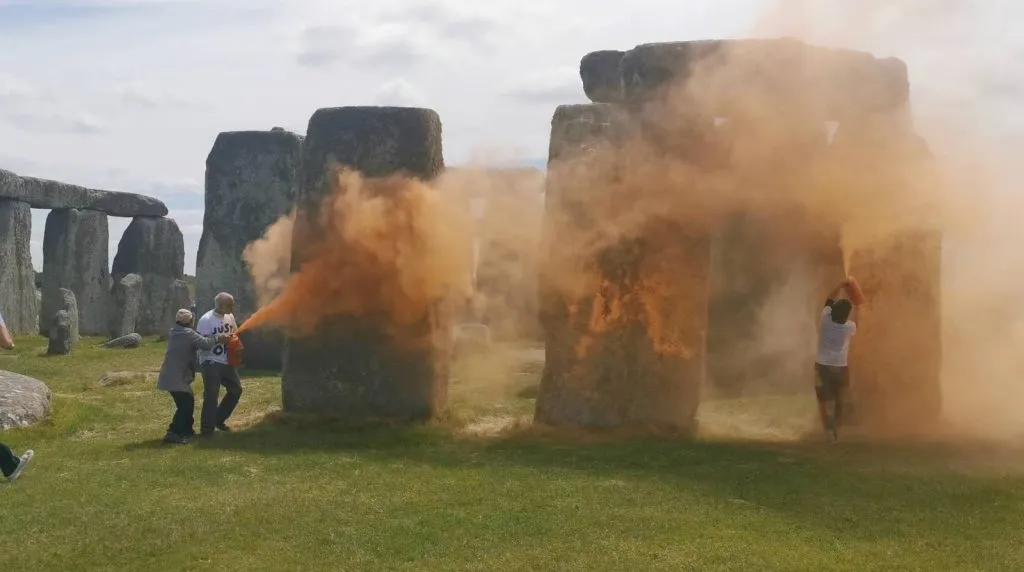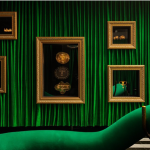
To receive Morning Links in your inbox every weekday, sign up for our Breakfast with ARTnews newsletter.
THE HEADLINES
STONEHENGE VANDALISM. Two Just Stop Oil climate activists sprayed orange powder paint on Stonehenge on Wednesday, reports Harrison Jacobs for ARTnews. The two demonstrators can be seen in the midst of their protest via a video the group posted on social media, as bystanders tried to drag them away from the ancient structures. Both demonstrators were soon arrested. While the spray paint is made of “orange corn flour,” according to the group, archaeologist Michael Pitts told the BBC that the megaliths “are sensitive and they are completely covered in prehistoric markings which remain to be fully studied and any surface damage to the stones is hugely concerning.” The organization stated the action was meant to call for the UK government to sign a “legally binding treaty to phase out fossil fuels by 2030.”
VATICAN’S INDIGENOUS HOLDINGS. Canadian Prime Minister Justin Trudeau urged Pope Francis to return cultural artifacts from the Vatican to Native Peoples, in a social media post on June 14, following a meeting with the pontiff. “I thanked His Holiness for taking up the work of Reconciliation, and I advocated for the next step – returning cultural artefacts from the Vatican to Indigenous Peoples in Canada,” he tweeted on X. Trudeau’s comments came following a recently reported investigation by the Globe and Mail, which found little progress had been made on the issue, despite the Catholic Church’s commitments to restitute First Nation artIfacts.
THE DIGEST
Members of Germany’s center-right Christian Democratic Union have called for the boycott of a group art exhibition at the Osnabrück Kunsthalle in northwest Germany. The show titled “Kinder, Hört mal alle her!” [Kids, listen up!] addresses themes of domestic violence and cannibalism, and comes with a content warning for children, as well as advising viewer discretion. [The Art Newspaper]
A Manhattan Supreme Court judge has dismissed a lawsuit demanding the restitution of Pablo Picasso’s 1904 painting Woman Ironing, to relatives of its former owner, Karl Adler. Claimants said Adler had sold the painting under duress in 1938 to fund his family’s escape from the Nazi’s, but judge Andrew Borrok said there was not sufficient evidence to back their assertion, and when the family was asked in the 1970’s about the painting’s provenance, they “never in any way indicated that the sale was tainted by duress.” [ARTnews]
Berlin lawmaker Felor Badenburg is preparing a broader reform to restrict distribution of funding to cultural organizations and beyond, after failing to require groups requesting government grants to declare their opposition to anti-Semitism. “Tax money should not benefit people or groups that do not stand on the basis of the Basic Law. It is about hostility to the constitution and democracy,” Badenburg told German reporters. [DPA and Monopol]
The 2024 Gwangju Biennale Pavilion project, held September 7 to December 1 at the next Gwangju Biennale, will be hosted across multiple venues in the Korean city, and expanded from nine to 32 participants, including Argentina, New Zealand, Peru, Spain, and Qatar. Its theme will respond to the main biennale topic: “Pansori, a soundscape of the 21st century,” curated by Nicolas Bourriaud. [ArtAsiaPacific]
Van Cleef & Arpels is opening a second campus of its School for Jewelry Art in Paris, which will also serve as an exhibition space. The 14,000-square-foot, 18th century town house in Montmartre is the former home of a noble who rescued Marie Antoinette’s jewels and it will launch with an exhibit about stage jewelry. [WWD]
Archaeologists have discovered a votive altar on Mount Arriaundi in Spain, while excavating a medieval monastery. The votive altar dates to the 1st century CE, from the Roman period, and experts believe it was dedicated to Larrahe, an ancient Basque deity. [Heritage Daily]
On June 23, collector Reinhard Ernst will open a new, eponymous museum in Wiesbaden, Germany designed by the late Pritzker Prize-winning Japanese architect Fumihiko Maki. Works on view in the over 2,5000 square-meter space will include pieces by Helen Frankenthaler, Tony Cragg, Lee Krasner, Frank Stella, Pierre Soulages, and Yuichi Inoue. [The Art Newspaper]
Can Los Angeles’ Oceanwide Plaza abandoned skyscrapers, made famous by graffiti artists be saved? Reporter Vincent takes a closer look at “one of the region’s all-time real estate catastrophes.” [The Los Angeles Times]
THE KICKER
JOHN LENNON’S PATEK PHILIPPE. For The New Yorker, Jay Fielden has dug into the mysterious story behind John Lennon’s mythic stolen Pateck Phlippe 2499 watch, gifted to him by Yoko Ono just a few months before he died, and now at the center of an ownership dispute in a Geneva court. The “El Dorado of lost watches” with a sought-after perpetual-calendar chronograph, and one of only 349 ever made, it may be the most valuable wristwatch in existence, writes Fielden, estimated to be worth between ten and 40 million dollars at auction. For years Fielden traced how this watch, which had been locked in a room in Lennon’s apartment after his death, was apparently stolen in 2005, and ended up in the hands of an unnamed man court documents call Mr. A, who claims he’s now its legal owner. A tough case, which is now overseen by Switzerland’s Supreme Court. The identity of its original owner, however, remains glaringly obvious to all: Ono left a famous, secret inscription to Lennon on the back of the watch.

